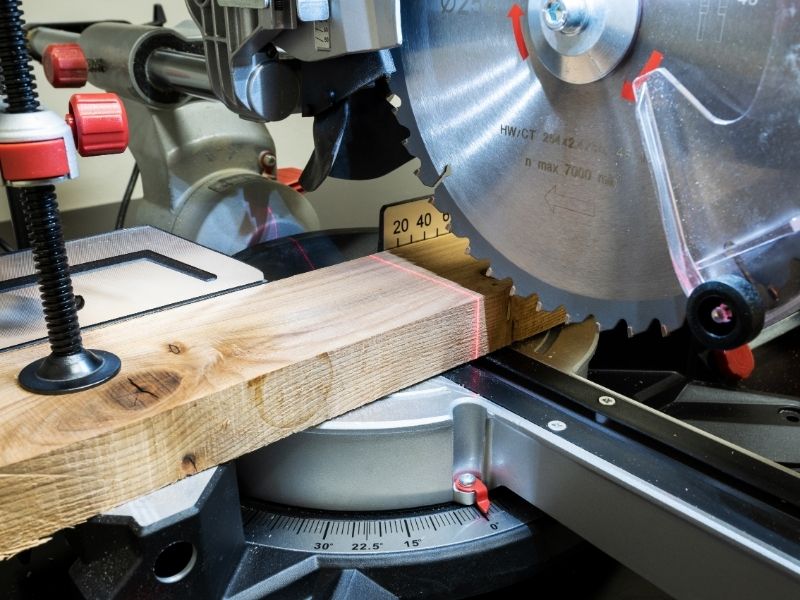
If you’re just getting into woodworking, you may find yourself asking, what are mitre saws used for? There’s no doubt they’re a popular, power tool, capable of making quick, crosscuts in workpieces. Also known as drop saws, miter saws are commonly used for cutting molding and trim. They work by pulling a large backsaw or mounted circular saw blade down on material in a quick motion. Most miter saws are easy to move about with common blade sizes ranging from 8 to 12 inches.
Although miter saws have a limited range of use, they are capable of making at least two types of cuts, and sometimes three (depending on the saw). To do it with a different type of saw or tool usually just makes things too complicated. Essentially it is the types of cuts a miter saw can do, which really makes the saw worth their weight in gold.
[lwptoc title=”Quick Links To Items On This Page” toggle=”1″ labelShow=”show” labelHide=”hide” hideItems=”1″]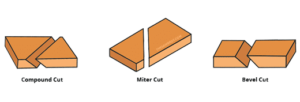
Regular Crosscuts
A crosscut refers to any straight-angled cut that you perform across a workpiece that is parallel with the edges. This is something as simple as cutting off the end of a 2×4 board to make it a 2×3.
Therefore, if you want to cut a board in half, a miter saw will be your ‘go to’ power tool. Sure you could use a time consuming handsaw, or even a circular saw or radial arm saw etc.), but a miter saw is still the best, most efficient option.
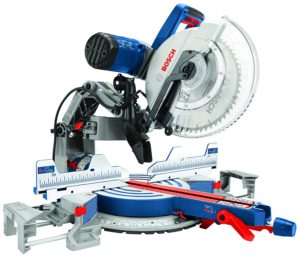
There are three reasons why this is the case:
- Miter saws are powerful yet stable. Therefore, it is unlikely that you would encounter a board that it couldn’t carve up. Also, as it’s stationary and fairly heavy, just put it on your workbench and it won’t move when you set wood on it for cutting.
- Miter saws make it easy to line up the cut line (which is not something you want to get wrong). Just set the board against the fence, and you can move the handle down to see where the blade will cut the board. It’s always a bonus if you get one with a laser guide to show you clearly where the cut should be. In this instance, you won’t even have to set the saw against the work piece then.
- Lastly, with a sliding miter saw you can cut fairly wide boards. Eg, a 12″ sliding saw will cut a board around 12″ wide (depending on its thickness).This task especially would be super difficult to complete with the same accuracy with almost any other tool – unless you already have a radial arm saw or an expensive table saw.
Why is it good to use a miter saw for cross-cutting?
Crosscuts are easily the most basic of all cuts, something that any other saw is certainly able to do. The advantage with a miter saw is that you simply drop the blade down onto the workpiece in one motion, which is much easier and precise than any other method that relies on you guiding a blade through a piece.
Miter Cut (angle cut)
As you’re probably aware, a miter cut is where the saw gets its name from. Miter cuts refer to any angled cut you make through a piece. While crosscuts run parallel to a workpiece’s sides, miters run diagonally at any degree of angle.
It doesn’t mean the blade itself is angled, however, just the direction that it’s cutting. There are guides on the miter saw’s base that lets you position your piece at the exact angle you need it cut before dropping it down.
Again, just as with crosscuts, this is much easier to do when using a miter saw that can perform the cut without any manual manoeuvring of the blade. The miter cut is made by turning the saw to one side of the other.
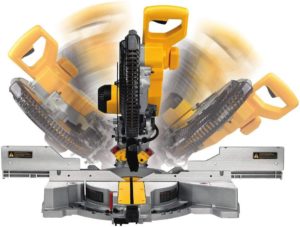
A lot of miter saws can cut around 50° to the left and right with more premium models able to extend this. Blade size and length of cut will limit the range though.
Miter cuts are useful for……
- Woodworking projects with angles! Although can make a lot of woodworking projects and furniture with just right angles, inevitably you will find you’ll need to miter some boards together to complete your project.
For this reason, a miter joint is a typical occurence will be facing. Even in something simple like a photo frame, you will need to miter the corners.
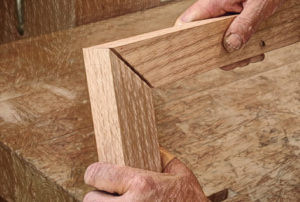
- Likewise trim work will need all kinds of angles cut into it. It you’re planning on some DIY around the house, a miter saw is without question, the best way to cut trim.

- If you DIY project sees you tackling the floor, then chances are you you will need to slide your saw around and cut something at an angle. This is especially so if the room you are working on isn’t even square (yep – been there before) and you are going to want a snug fit.
Bevel and Compound Angle Cuts
A beveled cut is any cut that is angled through the workpiece instead of across it. A compound miter saw can cut workpieces with two angle settings; bevel and miter. Admittedly this type of cut is more intricate and tricky but can be necessary when you face complex angles. Eg boxes with slanted sides or concrete forms for post caps.
You may not need this type of cut often, but when you do you will be glad that you have the tool to accomplish it.
Another advantage to having a miter saw that will make bevel cuts, is that you can cut an angle into a wide board such as a 1×10. This is very achievable with a sliding saw.
- Repeatable Cuts
Sometimes it is necessary to make several cuts that are the same size. To accomplish this, just put a stop on one end of the work surface and butt your workpiece against that stop. You will be able to repeatedly make cuts that are the exact same length.
There’s no doubt this would be tricky to do with hand tools or even a circular saw.
- Built in Workbench
It’s awesome to have a workstation that integrates the miter saw into its functionality – especially if you’re planning on getting a lot of use from your miter saw. It makes it really easy to position and hold boards in place while you make the cut.
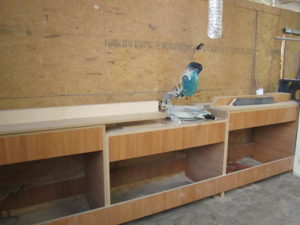
Pro Tip: ensure that the miter saw sits below the surface so that the work area is even all the way across.
- Sliding Saw
The biggest advantage of a sliding miter saw is that it allows you to cut wider pieces of wood. If given the opportunity, it is always best to opt for the sliding miter saw as it’s tiring to flip the piece over every time you cut a board that is too wide.
What Are Mitre Saws Used For (practical applications)?
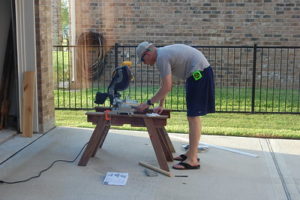
Since miter saws are primarily used for making miter cuts, they are especially helpful for making things like frames, crown molding, gates, boxes, ledges, and more. Although their range might have it’s limitations, miter saws are preferred for some of the most common woodworking and construction needs.
The speed of the fast cutting action and ease of use when making angle adjustments, lets users carve up pieces to exact angles in just a few seconds. This makes them a very efficient machine.
They are also handy for when you need several smaller pieces out of a lengthy workpiece. Just grab a pencil and measuring tape and you can quickly mark where each cut should be. It won’t take you long to makes cuts on the piece working all the way through it in a minute or so (depending on the size).
Where Would You Use a Miter Saw?
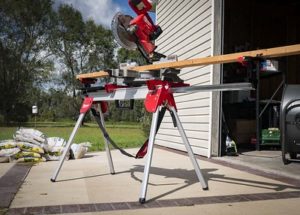
It is fairly common on a construction sites to see a miter saw – especially during the framing phase. Large miter saws can be set up and used to trim down wall studs and other framing components, and also cut the required angles in any of them as well, all in just a few minutes.
Who Would Use a Miter saw?
All sorts of construction workers like fence builders and roofers may bring their miter saws over to the job site. Miter saws allow them to trim down fence pieces and roofing materials accurately and quickly.
Likewise, miter saws are often used by plumbers who (with the right blade installed) are able to trim piping.
Lastly the home hobbyist or DIY enthusiast, use miter saws regularly as it offers an accurate, quick and simple way to make smaller crosscuts, miters, and sometimes bevel cuts conveniently in a home garage or shop.
Final Thoughts…..
Remind me again, what are mitre saws used for?
- Making regular board cuts
- Angled, miter cuts
- Compound angle cuts
- General DIY work such as flooring, remodeling, etc.
- Trim work
If you plan on doing any of these tasks you will definitely want to get a miter saw. As a woodworker I would use mine more than any other tool (except maybe my cordless drill).
Sure there are other ways to make all of these cuts – but none of them are as versatile and easy to use as the humble miter saw!
Click here for our buyers guide on What To Look For When Buying A Miter Saw. This review guide will address what makes a good miter saw and our top 5 recommended products that are trending well in 2020.
If you’re wondering, What Size Miter Saw Do I need, click on our post that reviews the pros and cons of the different size miter saws available.
After a different tool? Check out our other power tool reviews on:
Best Circular Saws For Beginners
